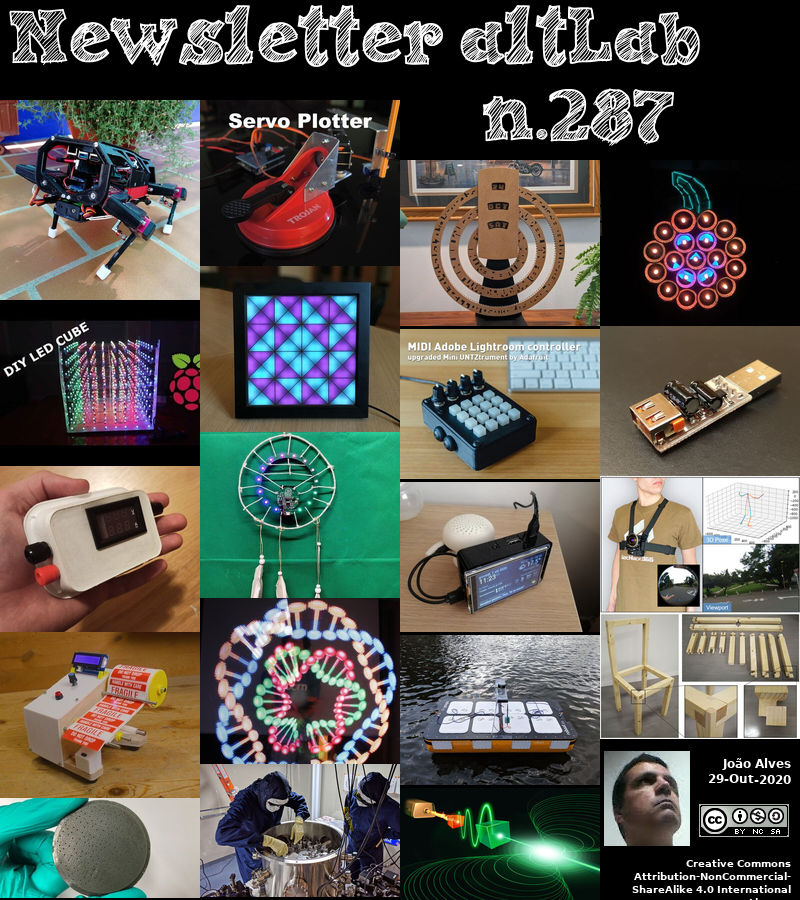2020-10-29 - Nº 287
Editorial
Esta é a Newsletter Nº 287 que se apresenta com o mesmo formato que as anteriores. Se gostar da Newsletter partilhe-a!
Todas as Newsletters encontram-se indexadas no link.
Esta Newsletter tem os seguintes tópicos:
Faz hoje anos que nascia, em 1925, o Matemático britânico nascido na Alemanha Klaus Friedrich Roth. O seu principal trabalho tem sido a teoria dos números, particularmente a teoria analítica dos números. Ele resolveu no famoso problema de Thue-Siegel relativo à aproximação de números algébricos por números racionais (pelo qual ganhou a medalha Fiels). Roth também provou em 1952 que uma sequência sem três números na progressão aritmética tem densidade zero (uma conjectura de Erdös e Turán de 1935).
Em 1991, a sonda espacial Galileo tornou-se o primeiro objecto humano a voar além de um asteróide, Gaspra, fazendo a sua maior aproximação a uma distância de 1.604 km, passando a uma velocidade de 8 km/s. O encontro forneceu muitos dados, incluindo 150 imagens, que mostraram que Gaspra tem numerosas crateras indicando que sofreu inúmeras colisões desde a sua formação. Gaspra tem cerca de 20 km de comprimento e orbita o Sol no cinturão de asteróides principal entre Marte e Júpiter. Gaspra, asteróide 951, foi descoberto pelo astrónomo ucraniano Grigoriy N. Neujamin, que o nomeou após um retiro no Mar Negro.
Nesta semana que passou foi lançada a nova versão da distribuição de Linux do projecto Fedora. O Fedora 33 tem como principais novidades o GNOME 3.38, a swap on z-ram (Swap comprimida em RAM) e o filesystem BTRFS por omissão. Além destas alterações, esta distro inclui o Python 3.9, o Java 11, o Perl 5.32, a Glibc 2.32, o LLVM 11 entre outros. A variante Fedora IoT passou a ser uma versão oficial e suportada. Os pacotes passaram a ser compilados com a optimização LTO (Link-time Optimizations) que irá igualmente aumentar o desempenho das aplicações.
Também nesta semana que passou o sistema SOFIA (Stratospheric Observatory for Infrared Astronomy) da NASA confirmou, pela primeira vez, a água na superfície da lua iluminada pelo sol. Esta descoberta indica que a água pode estar distribuída pela superfície lunar, e não limitada a lugares frios e escuros.
Na Newsletter desta semana apresentamos diversas noticias, artigos científicos assim como projetos de maker. São apresentadas as revistas MagPI Nº99 de Novembro e as revistas neweletronics de 26 e 27 de Outubro. É igualmente apresentado o livro "Create Graphical User Interfaces with Python".
 João Alves ([email protected])
João Alves ([email protected])
O conteúdo da Newsletter encontra-se sob a licença  Creative Commons Attribution-NonCommercial-ShareAlike 4.0 International License.
Creative Commons Attribution-NonCommercial-ShareAlike 4.0 International License.
Novidades da Semana

Fedora 33 is officially here!
"Today, I’m excited to share the results of the hard work of thousands of contributors to the Fedora Project: our latest release, Fedora 33, is here! This is a big release with a lot of change, but I believe all that work will also make it a comfortable one, fulfilling our goal of bringing you the latest stable, powerful, and robust free and open source software in many easy to use offerings. If you just want to get to the bits without delay, head over to https://getfedora.org/ right now. For details, read on! Find the Fedora flavor that’s right for you! Fedora Editions are targeted outputs geared toward specific “showcase” uses on the desktop, in server and cloud environments—and now for Internet of Things as well." [...]
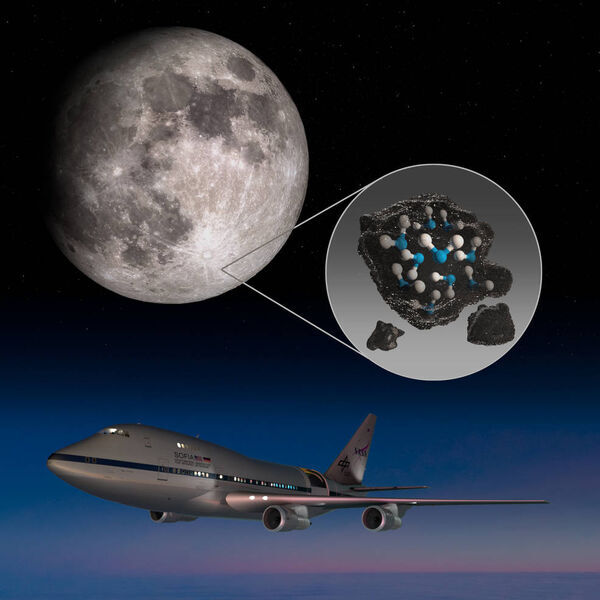
NASA’s SOFIA Discovers Water on Sunlit Surface of Moon
"NASA’s Stratospheric Observatory for Infrared Astronomy (SOFIA) has confirmed, for the first time, water on the sunlit surface of the Moon. This discovery indicates that water may be distributed across the lunar surface, and not limited to cold, shadowed places. SOFIA has detected water molecules (H2O) in Clavius Crater, one of the largest craters visible from Earth, located in the Moon’s southern hemisphere. Previous observations of the Moon’s surface detected some form of hydrogen, but were unable to distinguish between water and its close chemical relative, hydroxyl (OH). Data from this location reveal water in concentrations of 100 to 412 parts per million – roughly equivalent to a 12-ounce bottle of water – trapped in a cubic meter of soil spread across the lunar surface. The results are published in the latest issue of Nature Astronomy." [...]
Outras Notícias
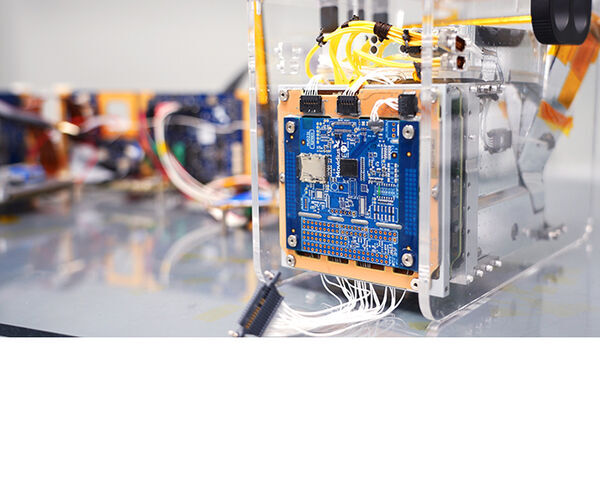
Intel Powers First Satellite with AI on Board
"As ubiquitous as artificial intelligence has become in modern life — from boosting our understanding of the cosmos to surfacing entertaining videos on your phone — AI hasn’t yet found its way into orbit. That is until Sept. 2, when an experimental satellite about the size of a cereal box was ejected from a rocket’s dispenser along with 45 other similarly small satellites. The satellite, named PhiSat-1, is now soaring at over 17,000 mph (27,500 kmh) in sun-synchronous orbit about 329 miles (530 km) overhead. PhiSat-1 contains a new hyperspectral-thermal camera and onboard AI processing thanks to an Intel® Movidius™ Myriad™ 2 Vision Processing Unit (VPU) — the same chip inside many smart cameras and even a $99 selfie drone here on Earth. PhiSat-1 is actually one of a pair of satellites on a mission to monitor polar ice and soil moisture, while also testing intersatellite communication systems in order to create a future network of federated satellites. The first problem the Myriad 2 is helping to solve?" [...]

AMD to Acquire Xilinx, Creating the Industry’s High Performance Computing Leader
"AMD (NASDAQ: AMD) and Xilinx (NASDAQ: XLNX) today announced they have entered into a definitive agreement for AMD to acquire Xilinx in an all-stock transaction valued at $35 billion. The combination will create the industry’s leading high performance computing company, significantly expanding the breadth of AMD’s product portfolio and customer set across diverse growth markets where Xilinx is an established leader. The transaction is expected to be immediately accretive to AMD margins, EPS and free cash flow generation and deliver industry-leading growth. The acquisition brings together two industry leaders with complementary product portfolios and customers. AMD will offer the industry’s strongest portfolio of high performance processor technologies, combining CPUs, GPUs, FPGAs, Adaptive SoCs and deep software expertise to enable leadership computing platforms for cloud, edge and end devices. Together, the combined company will capitalize on opportunities spanning some of the industry’s most important growth segments from the data center to gaming, PCs, communications, automotive, industrial, aerospace and defense." [...]

Industry’s First Highly Integrated Radiation-Hardened Motor Controller Consolidates Essential Functions for the Motor Control and Position Sensing Circuitry of Satellite Elements into a Single Chip
"Microchip’s LX7720 device increases reliability while reducing weight and board area. The need to reduce size, weight and power (SWaP) on satellites and other space systems continues to challenge the aerospace market. Combining more than 20 commonly used functions into a single chip, Microchip Technology Inc. (Nasdaq: MCHP) today announced the LX7720 radiation-hardened mixed signal motor controller, the latest addition to its Space System Manager (SSM) product family. As the industry’s first highly integrated radiation-hardened by design (RHBD) motor control integrated circuit (IC), the LX7720 significantly reduces weight and board space relative to conventional discrete motor control circuits. By reducing the number of components on a system, developers can inspect and test fewer parts, while also minimizing the physical points of potential failure due to a smaller number of connections and solder joints. The LX7720 controller offers a unique solution for satellite manufacturers sensitive to board area and weight reduction by consolidating essential functions for the motor control and position sensing circuitry required for robotics, multi-axis pointing mechanisms and precise motion control of optical elements." [...]

Toshiba Announces Updated 4TB, 6TB and 8TB Enterprise Capacity HDD Models
"The MG08-D Series delivers reliability and power efficiency to enterprise and business-critical applications workloads Toshiba Electronic Devices & Storage Corporation (“Toshiba”) announces the Toshiba MG08-D Series HDDs, designed for a wide variety of business-critical applications, such as email and CRM (Customer Resource Management), data analysis for business intelligence, small-medium business servers, and data-retention and compliance archiving. Toshiba’s 7th generation air mechanical design provides better power efficiency and a lower component count to deliver better total cost of ownership than its earlier generation models. The new series features 4TB, 6TB and 8TB models, in both SATA and SAS interfaces. The new 4TB[1] models are available in 512e, 4Kn and 512n sector models, and the 6TB and 8TB models are available in 512e and 4Kn sector models, assuring plug-and-play interoperability for applications using prior 4TB models. “Toshiba’s new MG08-D Series delivers new levels of reliability and power efficiency to enterprise and business-critical server and storage platforms,” said Shuji Takaoka, General Manager of Storage Products Sales & Marketing Division at Toshiba Electronic Devices & Storage Corporation. “Toshiba’s 7th generation conventional mechanical design utilizes Conventional Magnetic Recording technology to deliver plug-and-play versatility that is compatible with the widest range of applications and operating system environments.” The MG08-D Series provides many industry-standard features, including 7200rpm performance, a 3.5-inch[2] form factor, choice of SATA 6Gbit/s or 12Gbit/s SAS Interface[3], and a 550TB a year workload[4] rating." [...]

STMicroelectronics Simplifies Development of Cordless Power Tools with Plug-and-Play STSPIN32 Prototype Boards
"Aiding the development of state-of-the-art cordless home and garden power tools, STMicroelectronics has introduced two new plug-and-play boards for controlling 3-phase brushless motors powered by up to 56V Li-ion batteries. Based on ST’s highly integrated STSPIN32 motor-control Systems-in-Package, the STEVAL-PTOOL1V1 and STEVAL-PTOOL2V1 evaluation boards fulfil key requirements of power tools including small dimensions and low standby current. Firmware is supplied for six-step motor commutation using Hall-effect rotor-position sensing, which ensures low torque ripple and optimum power efficiency. The STEVAL-PTOOL1V1 for equipment powered by Li-ion battery packs from two cells (7.4V) to six cells (22.2V) has a 70mm x 30mm footprint and delivers up to 15A continuous current. Standby current is less than 1µA. At the heart of the board is the STSPIN32F0B motor controller, which contains an STM32F0* microcontroller, 3-phase half-bridge gate driver, 12V and 3.3V voltage regulators, an op-amp for current sensing and power-stage protection features such as programmable over-current protection (OCP), cross-conduction prevention and under-voltage lockout (UVLO)." [...]

Xilinx Introduces Breakthrough Zynq RFSoC DFE for Mass 5G Radio Deployments
"New class of adaptive radio platforms combines flexibility for evolving 5G standards and a hardened radio digital front-end for performance, power, and cost effectiveness Xilinx, Inc., (NASDAQ: XLNX) today introduced Zynq® RFSoC DFE, a breakthrough class of adaptive radio platforms designed to meet the evolving standards of 5G NR wireless applications. Zynq RFSoC DFE combines hardened digital front-end (DFE) blocks and adaptable logic to build high performance, low power, and cost-effective 5G NR radio solutions for a broad array of use cases ranging across 5G low-, mid-, and high- band spectrum. Zynq RFSoC DFE offers the best balance of technologies between the cost economies of an ASIC using hardened blocks and the flexibility, scalability, and time-to-market benefits of a programmable and adaptive SoC. This press release features multimedia. View the full release here: https://www.businesswire.com/news/home/20201027005317/en/ 5G radio requires solutions that not only meet bandwidth, power, and cost challenges for widespread deployment, but must also adapt to the three key 5G use cases: enhanced Mobile Broadband, massive Machine Type Communication, and Ultra-Reliable Low-Latency Communication. In addition, solutions must scale for evolving 5G standards such as OpenRAN (O-RAN) as well as new and disruptive 5G business models." [...]

Renesas Extends RA MCU Family with RA6T1 MCU Group for Motor Control and AI-based Endpoint Predictive Maintenance
"Arm Cortex-M4-based MCU Rich Peripherals Reduce Motor Control BOM Cost and Supports Predictive Maintenance Solution with Google’s TensorFlow Lite for Microcontrollers Renesas Electronics Corporation (TSE:6723), a premier supplier of advanced semiconductor solutions, today announced the extension of its microcontroller (MCU) portfolio designed for motor control applications targeting smart homes, industrial automation, and building automation. Featuring a rich set of peripheral functions and AI-based failure detection, the four new RA6T1 Group MCUs are the latest members of Renesas’ rapidly expanding Arm®-based RA Family, and the first RA MCUs designed for the unique needs of motor control in home appliances, HVAC, solar inverters, and AC drives. “As home appliances and building and industrial automation equipment become smarter and more complex, manufacturers are grappling with rising BOM costs to support increasing motor performance demands,” said Roger Wendelken, Senior Vice President of Renesas’ IoT and Infrastructure Business Unit. “The RA6T1 MCUs combine the superior performance and flexibility of the Arm-based RA Family with Renesas’ long-standing motor control expertise. In addition, with the emergence of AI-based needs, Renesas is excited to complement Google’s TensorFlow Lite supported platforms with the RA6T1 motor control and predictive maintenance solution.” “AI and machine learning are taking predictive maintenance to the next level as the industry advances toward Maintenance 4.0. We are excited to join forces with Renesas and accelerate the adoption of smart home and Industrial IoT applications,” said Ian Nappier, Product Manager at Google." [...]
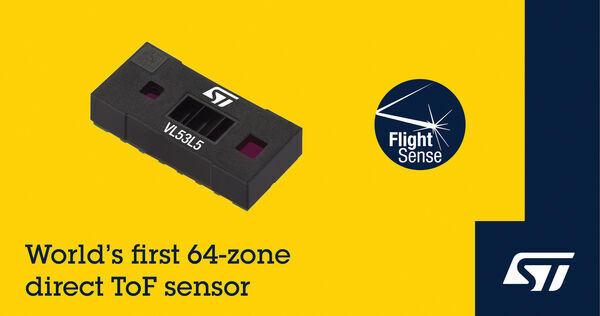
STMicroelectronics Introduces World’s First All-in-One, Multi-Zone, Direct Time-of-Flight Module
"STMicroelectronics (NYSE: STM), a global semiconductor leader serving customers across the spectrum of electronics applications, has extended its portfolio of FlightSense™ Time-of-Flight (ToF) sensors with the world’s first 64-zone device that breaks a scene into separate areas to help an imaging system build the most detailed spatial understanding of a scene. This first-of-its-kind product comprises a 940nm Vertical Cavity Surface Emission Laser (VCSEL) light source, a System-on-Chip sensor integrating a VCSEL driver, the receiving array of Single Photon Avalanche Diodes(SPADs), and a low-power 32-bit MCU core and accelerator running sophisticated firmware. TheVL53L5 retains the Class 1 certification of all ST’sFlightSensesensors and is fully eye-safe for consumer products. Housed in a miniature module, the VL53L5 ToFsensor contains optical elements in the receive aperture that creates 64 ranging zones, unlocking a host of new features and use cases. “The multi-zone VL53L5 FlightSense direct Time-of-Flight sensor uses our most advanced 40nm SPAD production process to offer outstanding 4m ranging performance and up to 64 ranging zones that help an imaging system build a detailed spatial understanding of the scene,” said Eric Aussedat, General Manager of ST’s Imaging Division. “Delivering 64x more ranging zones than previously available, the VL53L5 offers radical performance improvement in laser autofocus, touch-to-focus, presence detection, and gesture interfaces while helping developers create even more innovative imaging applications.” With a vertically integrated manufacturing model for its FlightSense sensors, ST builds its SPAD wafers on a 40nm proprietary silicon process in the Company’s state-of-the-art 12” wafer plant at Crolles, France before assembling all of the module components in ST’s back-end plants in Asia." [...]
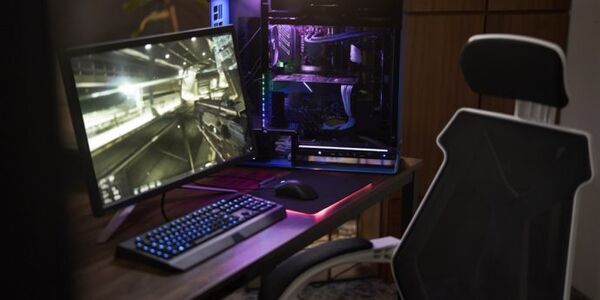
Intel’s 11th Gen Processor (Rocket Lake-S) Architecture Detailed
"Earlier this year, Intel made desktop PCs even better with 10th Gen Intel® Core™ S-series processors, headlined by the Intel Core i9-10900K. In the first quarter of 2021, the 11th Gen Intel Core S-series desktop processors (code-named “Rocket Lake-S”) will bring even more performance to gamers and PC enthusiasts. About the Architecture: The 11th Gen Intel Core S-series desktop processor will introduce a new desktop architecture, called Cypress Cove, designed to transform hardware and software efficiency and increase performance. This will enable double-digit percentage IPC performance improvement1 (gen over gen) and deliver enhanced Intel® UHD™ graphics featuring the Intel® Xe Graphics architecture2. Why Frequency and IPC Matter: Games and most applications continue to depend on high-frequency cores to drive high frame rates and lower latency. In addition, the number of IPC improve on the performance that frequency delivers by executing more instructions." [...]

Impact Craters Reveal Details of Titan's Dynamic Surface Weathering
"New research on nine craters of Saturn's largest moon provides more details about how weathering affects the evolution of the surface - and what lies beneath. Scientists have used data from NASA's Cassini mission to delve into the impact craters on the surface of Titan, revealing more detail than ever before about how the craters evolve and how weather drives changes on the surface of Saturn's mammoth moon. Like Earth, Titan has a thick atmosphere that acts as a protective shield from meteoroids; meanwhile, erosion and other geologic processes efficiently erase craters made by meteoroids that do reach the surface. The result is far fewer impacts and craters than on other moons. Even so, because impacts stir up what lies beneath and expose it, Titan's impact craters reveal a lot. The new examination showed that they can be split into two categories: those in the fields of dunes around Titan's equator and those in the vast plains at midlatitudes (between the equatorial zone and the poles)." [...]

NASA’s OSIRIS-REx Successfully Stows Sample of Asteroid Bennu
"NASA’s Origins, Spectral Interpretation, Resource Identification, Security, Regolith Explorer (OSIRIS-REx) mission has successfully stowed the spacecraft’s Sample Return Capsule (SRC) and its abundant sample of asteroid Bennu. On Wednesday, Oct. 28, the mission team sent commands to the spacecraft, instructing it to close the capsule – marking the end of one of the most challenging phases of the mission. “This achievement by OSIRIS-REx on behalf of NASA and the world has lifted our vision to the higher things we can achieve together, as teams and nations,” said NASA Administrator Jim Bridenstine. “Together a team comprising industry, academia and international partners, and a talented and diverse team of NASA employees with all types of expertise, has put us on course to vastly increase our collection on Earth of samples from space. Samples like this are going to transform what we know about our universe and ourselves, which is at the base of all NASA’s endeavors.” The mission team spent two days working around the clock to carry out the stowage procedure, with preparations for the stowage event beginning Oct. 24. The process to stow the sample is unique compared to other spacecraft operations and required the team’s continuous oversight and input over the two-day period." [...]

312 Days in the Stratosphere
"What does a balloon do while drifting a year through the stratosphere? Earlier this year one of our systems set a new Loon flight duration record of 312 flight days, so we’ve been asking ourselves this question as the answer becomes more and more relevant at Loon. HBAL703 launched from Puerto Rico in May, 2019, navigated to Peru, and then provided test service for three months. Many of our best flight systems, at a certain point, are devoted to “science”, i.e., our obsession with figuring out the secret of very, very healthy balloons. This flight system was sent south to circumnavigate the globe eventually settling over the deep Pacific Ocean to float on the winds for another seven months¹. Finally, it landed in Baja, Mexico, where our recovery team² collected the flight system for additional analysis in March, 2020." [...]

SpaceX reaches 100 successful launches with Starlink mission
"SpaceX launched another set of Starlink satellites Oct. 24, marking the 100th time the company has placed payloads into orbit. The Falcon 9 rocket lifted off from Space Launch Complex 40 at Cape Canaveral Air Force Station at 11:31 a.m. Eastern. The rocket’s upper stage deployed the payload of 60 Starlink satellites into orbit 63 minutes after liftoff. The first stage, making its third flight, landed on a droneship in the Atlantic Ocean. This was the 100th successful launch in the company’s history. That total includes 95 Falcon 9, three Falcon Heavy and two Falcon 1 launches." [...]
Ciência e Tecnologia

Autonomous boats could be your next ride
"Five years in the making, MIT’s autonomous floating vessels get a size upgrade and learn a new way to communicate aboard the waters. The feverish race to produce the shiniest, safest, speediest self-driving car has spilled over into our wheelchairs, scooters, and even golf carts. Recently, there’s been movement from land to sea, as marine autonomy stands to change the canals of our cities, with the potential to deliver goods and services and collect waste across our waterways. In an update to a five-year project from MIT’s Computer Science and Artificial Intelligence Laboratory (CSAIL) and the Senseable City Lab, researchers have been developing the world's first fleet of autonomous boats for the City of Amsterdam, the Netherlands, and have recently added a new, larger vessel to the group: “Roboat II.” Now sitting at 2 meters long, which is roughly a “Covid-friendly” 6 feet, the new robotic boat is capable of carrying passengers. Alongside the Amsterdam Institute for Advanced Metropolitan Solutions, the team also created navigation and control algorithms to update the communication and collaboration among the boats. “Roboat II navigates autonomously using algorithms similar to those used by self-driving cars, but now adapted for water,” says MIT Professor Daniela Rus, a senior author on a new paper about Roboat and the director of CSAIL." [...]
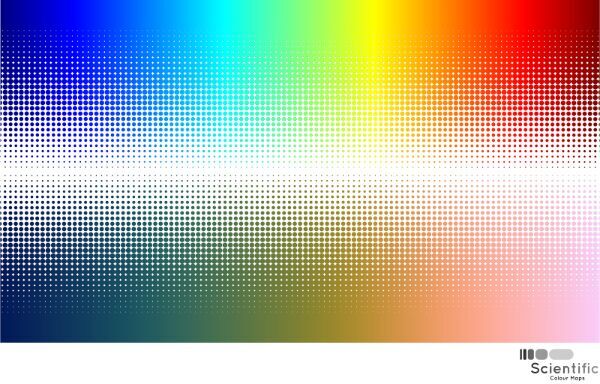
Using better colours in science
"Colours are often essential to convey scientific data - from weather maps to the surface of Mars. But did you ever consider that a combination of colours could be “unscientific“? Well, that’s the case with colour scales that use rainbow-like and red–green colours because they effectively distort data. And if that was not bad enough, they are unreadable to those with any form of colour blindness. Researchers from the Uni. of Oslo and Durham Uni." [...]

Chemical Scissors Snip 2D Transition Metal Dichalcogenides into Nanoribbon
"New ‘nanoribbon’ catalyst should slash cost of hydrogen production for clean fuels Researchers have identified a potential catalyst alternative – and an innovative way to produce them using chemical ‘scissors’ – that could make hydrogen production more economical. The research team led by Professor Sang Ouk Kim at the Department of Materials Science and Engineering published their work in Nature Communications. Hydrogen is likely to play a key role in the clean transition away from fossil fuels and other processes that produce greenhouse gas emissions. There is a raft of transportation sectors such as long-haul shipping and aviation that are difficult to electrify and so will require cleanly produced hydrogen as a fuel or as a feedstock for other carbon-neutral synthetic fuels. Likewise, fertilizer production and the steel sector are unlikely to be “de-carbonized” without cheap and clean hydrogen. The problem is that the cheapest methods by far of producing hydrogen gas is currently from natural gas, a process that itself produces the greenhouse gas carbon dioxide–which defeats the purpose." [...]
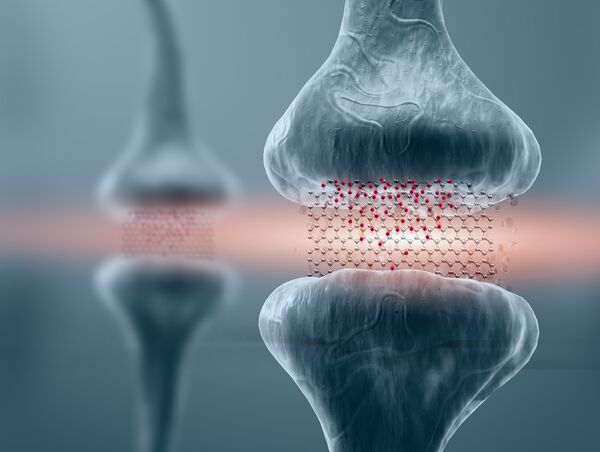
Graphene-based memory resistors show promise for brain-based computing
"As progress in traditional computing slows, new forms of computing are coming to the forefront. At Penn State, a team of engineers is attempting to pioneer a type of computing that mimics the efficiency of the brain’s neural networks while exploiting the brain’s analog nature. Modern computing is digital, made up of two states, on-off or one and zero. An analog computer, like the brain, has many possible states. It is the difference between flipping a light switch on or off and turning a dimmer switch to varying amounts of lighting. Neuromorphic or brain-inspired computing has been studied for more than 40 years, according to Saptarshi Das, the team leader and Penn State assistant professor of engineering science and mechanics." [...]

MonoEye: A human motion capture system using a single wearable camera
"Researchers at Tokyo Institute of Technology (Tokyo Tech) and Carnegie Mellon University have together developed a new human motion capture system that consists of a single ultra-wide fisheye camera mounted on the user's chest. The simplicity of their system could be conducive to a wide range of applications in the sports, medical and entertainment fields. Computer vision-based technologies are advancing rapidly owing to recent developments in integrating deep learning. In particular, human motion capture is a highly active research area driving advances for example in robotics, computer generated animation and sports science. Conventional motion capture systems in specially equipped studios typically rely on having several synchronized cameras attached to the ceiling and walls that capture movements by a person wearing a body suit fitted with numerous sensors. Such systems are often very expensive and limited in terms of the space and environment in which the wearer can move." [...]
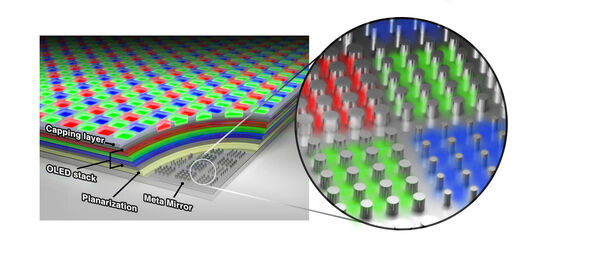
A team borrows solar panel tech to create ultrahigh-res OLED display
"The display would feature brighter images with purer colors and more than 10,000 pixels per inch. By expanding on existing designs for electrodes of ultra-thin solar panels, Stanford researchers and collaborators in Korea have developed a new architecture for OLED — organic light-emitting diode — displays that could enable televisions, smartphones and virtual or augmented reality devices with resolutions of up to 10,000 pixels per inch (PPI). (For comparison, the resolutions of new smartphones are around 400 to 500 PPI.) Such high-pixel-density displays will be able to provide stunning images with true-to-life detail — something that will be even more important for headset displays designed to sit just centimeters from our faces. The advance is based on research by Stanford University materials scientist Mark Brongersma in collaboration with the Samsung Advanced Institute of Technology (SAIT). Brongersma was initially put on this research path because he wanted to create an ultra-thin solar panel design." [...]
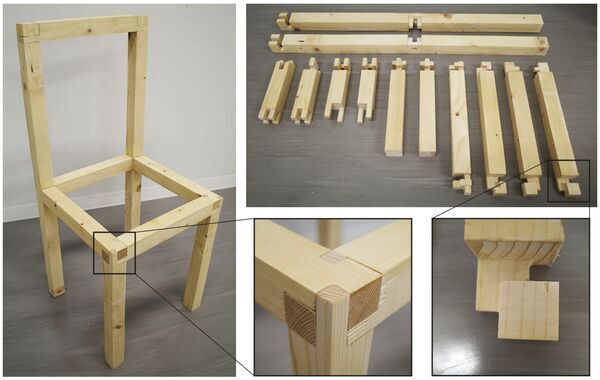
Simple software creates complex wooden joints
"An interactive system to design and fabricate structurally sound wood joints Wood is considered an attractive construction material for both aesthetic and environmental purposes. Construction of useful wood objects requires complicated structures and ways to connect components together. Researchers created a novel 3D design application to hugely simplify the design process and also provide milling machine instructions to efficiently produce the designed components. The designs do not require nails or glue, meaning items made with this system can be easily assembled, disassembled, reused, repaired or recycled. Carpentry is a practice as ancient as humanity itself. Equal parts art and engineering, it has figuratively and literally shaped the world around us." [...]

New materials help expand volumetric 3D printing
"Researchers at Lawrence Livermore National Laboratory (LLNL) have adapted a new class of materials for their groundbreaking volumetric 3D printing method that produces objects nearly instantly, greatly expanding the range of material properties achievable with the technique. The class of materials adapted for volumetric 3D printing are called thiol-ene resins, and they can be used with LLNL’s volumetric additive manufacturing (VAM) techniques, including Computed Axial Lithography (CAL), which produces objects by projecting beams of 3D-patterned light into a vial of resin. The vial spins as the light cures the liquid resin into a solid at the desired points in the volume, and the uncured resin is drained, leaving the 3D object behind in a matter of seconds. Previously, researchers worked with acrylate‐based resins that produced brittle and easily breakable objects using the CAL process. However, the new resin chemistry, created through the careful balancing of three different types of molecules, is more versatile and provides researchers with a flexible design space and wider range of mechanical performance. With thiol-ene resins, researchers were able to build tough and strong, as well as stretchable and flexible, objects, using a custom VAM printer at LLNL." [...]
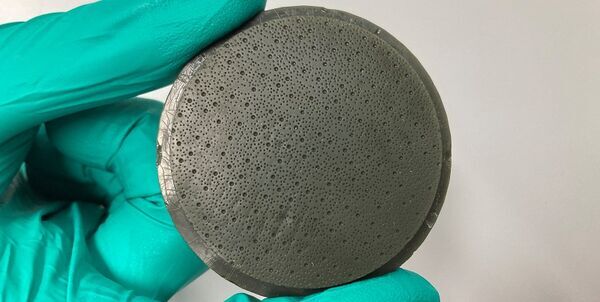
3D printing the first ever biomimetic tongue surface
"Scientists have created synthetic soft surfaces with tongue-like textures for the first time using 3D printing. This opens new possibilities for testing oral processing properties of food, nutritional technologies, pharmaceutics and dry mouth therapies. UK scientists led by the University of Leeds in collaboration with the University of Edinburgh have replicated the highly sophisticated surface design of a human tongue and demonstrated that their printed synthetic silicone structure mimics the topology, elasticity and wettability of the tongue’s surface. These factors are instrumental to how food or saliva interacts with the tongue, which in turn can affect mouthfeel, swallowing, speech, nutritional intake and quality of life. Particularly, since the onset of the COVID-19 pandemic, social distancing has posed significant challenges to carry out such sensory trials and consumer tests. A biomimetic tongue will be immensely helpful to increase development productivity and reducing manufacturers’ reliance on human trials in the early stages." [...]

Tiny moon shadows may harbor hidden stores of ice
"Hidden pockets of water could be much more common on the surface of the moon than scientists once suspected, according to new research led by CU Boulder. In some cases, these tiny patches of ice might exist in permanent shadows no bigger than a penny. “If you can imagine standing on the surface of the moon near one of its poles, you would see shadows all over the place,” said Paul Hayne, assistant professor in the Laboratory of Atmospheric and Space Physics at CU Boulder. “Many of those tiny shadows could be full of ice.” In a study published today in the journal Nature Astronomy, Hayne and his colleagues explored phenomena on the moon called “cold traps”—shadowy regions of the surface that exist in a state of eternal darkness. Many have gone without a single ray of sunlight for potentially billions of years. And these nooks and crannies may be a lot more numerous than previous data suggest." [...]
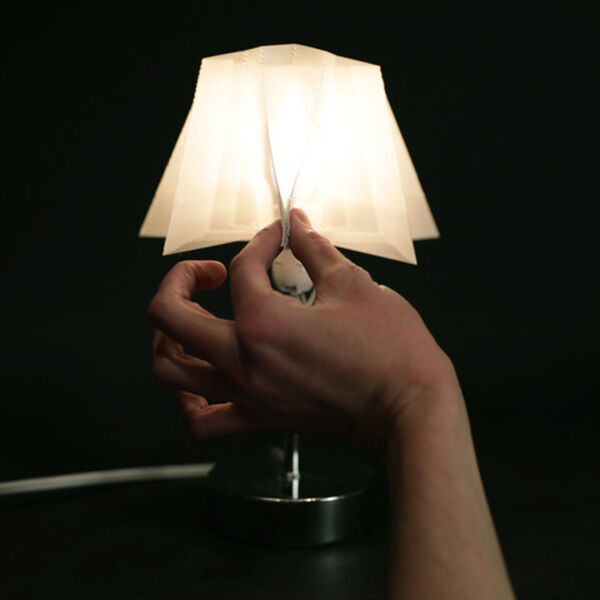
Leveraging a 3D printer “defect” to create a new quasi-textile
"Sometimes 3D printers mess up. They extrude too much material, or too little, or deposit material in the wrong spot. But what if this bug could be turned into a (fashionable) feature? Introducing DefeXtiles, a tulle-like textile that MIT Media Lab graduate student Jack Forman developed by controlling a common 3D printing defect — the under-extrusion of polymer filament. Forman used a standard, inexpensive 3D printer to produce sheets and complex 3D geometries with a woven-like structure based on the “glob-stretch” pattern produced by under-extrusion. Forman has printed these flexible and thin sheets into an interactive lampshade, full-sized skirts, a roll of fabric long enough to stretch across a baseball diamond, and intricately patterned lace, among other items." [...]

Light on efficiency loss in organic solar cells
"A deeper understanding of efficiency-limiting processes provides design rules for organic solar cell materials. Insight into energy losses that affect the conversion of light into electricity could help enhance organic solar cell efficiencies. A KAUST-led team of organic chemists, materials engineers, spectroscopists and theoretical physicists from six research groups has extensively evaluated efficiency-limiting processes in organic photovoltaic systems. To harvest light, cutting-edge organic solar cells rely on bulk heterojunctions, blends of light-responsive electron donor and acceptor materials. When light strikes the heterojunction, the resulting excited states are pairs of electrons and positively charged holes that need to be separated to make electric current. During charge separation, the donor gives electrons to the acceptor, and the acceptor transfers holes to the donor." [...]

Reliable quality-control of graphene and other 2D materials is routinely possible, Ames Lab researchers say
"Graphene and other single-atom-thick substances are a category of wonder materials, with researchers the world over investigating their electronic properties for potential applications in technologies as diverse as solar cells, novel semiconductors, sensors, and energy storage. The greatest challenge for the design of these single-layer or 2D materials into all their myriad potential uses is the need for an atom-by-atom perfection and uniformity that can be difficult and painstaking to achieve at such small scales, and difficult to assess as well. “We are trying to be more clever than nature in assembling these materials,” said Michael C. Tringides, a senior scientist at the U.S. Department of Energy’s Ames Laboratory and professor of physics at Iowa State University, who investigates the unique properties of 2D materials and metals grown on graphene, graphite, and other carbon coated surfaces. “And to do so, we’re forcing atoms to assemble in ways they normally would not. One of the major challenges of the field is to reliably produce high quality graphene and other materials like it.” Tringides and other scientists at Ames Laboratory have discovered and confirmed a method which could serve as an easy but reliable way to test the quality of graphene and other 2D materials. It takes advantage of the very broad background in surface electron diffraction, named the Bell-Shaped-Component (BSC) which strongly correlates to uniformly patterned, or “perfect” graphene." [...]

Scientists Discover New Structures in the Smallest Ice Cube
"The freezing of water is one of the most common processes. However, understanding the microstructure of ice and its hydrogen-bonding networks has been a challenge. The low-energy structure of water octamer is predicted to be nominally cubic, with eight tri-coordinated water molecules at the eight corners of the cube. Such tri-coordinated water molecules have been identified at the surface of ice. Only a few gas-phase studies have been achieved for experimental characterization of water octamer, and two nearly isoenergetic structures with D2d and S4 symmetry are found. This understanding now has been changed." [...]
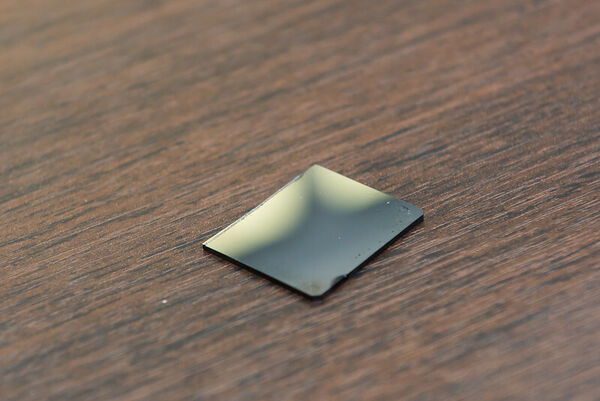
Scientists Manage to Improve Metallic Glasses
"Researchers at National University of Science and Technology MISIS (NUST MISIS) have managed to develop a unique method to process bulk metallic glasses. According to the authors of the study, they have managed to find processing conditions that significantly improve the quality of this promising material. The research results were published in Journal of Alloys and Compounds. Metallic glasses (amorphous metals) are materials which, unlike crystalline forms, don’t have a long range atomic order. According to the scientists, this makes the material high-strength, elastic, corrosion resistant; amorphous metals also have other useful properties, due to which they are in demand in instrument making, mechanical engineering, medicine and magneto-electrical engineering. NUST MISIS scientists explained that the material’s brittleness is one of the obstacles to its widespread use." [...]

The highest heat-resistant plastic ever is developed from biomass
"The use of biomass-derived plastics is one of the prime concerns to establish a sustainable society, which is incorporated as one of the Sustainable Development Goals. However, the use of most of the biomass-derived plastics is limited due to their low heat resistance. Collaborative research between JAIST and U-Tokyo has successfully developed the white-biotechnological conversion from cellulosic biomass into the aromatic polymers having the highest thermodegradation of all the plastics reported ever. Developing novel energy-efficient materials using biomass is frontiers to establish a sustainable environment. Plastics lightweight in nature produced from renewable biomass are prerequisites for developing a circular economy. However, currently available bioplastics are mostly aliphatic (e.g." [...]
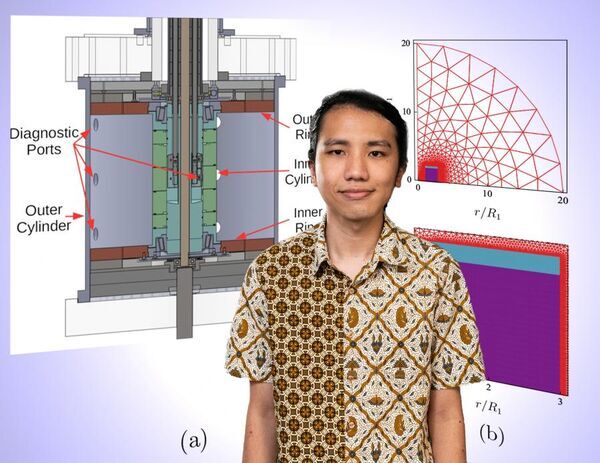
Exploring the source of stars and planets in a laboratory
"A new method for verifying a widely held but unproven theoretical explanation of the formation of stars and planets has been proposed by researchers at the U.S. Department of Energy’s (DOE) Princeton Plasma Physics Laboratory (PPPL). The method grows from simulation of the Princeton Magnetorotational Instability (MRI) Experiment, a unique laboratory device that aims to demonstrate the MRI process that is believed to have filled the cosmos with celestial bodies. Cosmic dust The novel device, designed to duplicate the process that causes swirling clouds of cosmic dust and plasma(link is external) to collapse into stars and planets, consists of two fluid-filled concentric cylinders that rotate at different speeds. The device seeks to replicate the instabilities that are thought to cause the swirling clouds to gradually shed what is called their angular momentum and collapse into the growing bodies that they orbit. Such momentum keeps the Earth and other planets firmly within their orbits. “In our simulations we can actually see the MRI develop in experiments,” said Himawan Winarto, a graduate student in the Princeton Program in Plasma Physics at PPPL and lead author of a paper in Physical Review E(link is external) that reports the findings." [...]
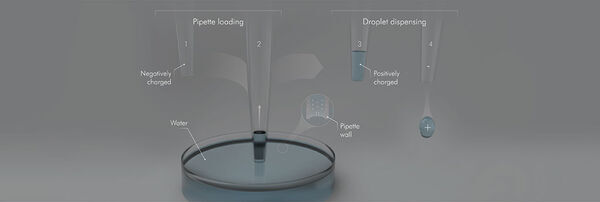
Probing water for an electrifying cause
"An experiment, elegant in its simplicity, helps explain why water becomes electrified when it touches hydrophobic surfaces. For over a century, scientists have been puzzled by the electrification of water when it is brought in contact with water-repellent or “hydrophobic” materials, such as paraffin wax, oils, air bubbles and perfluorinated membranes and sheets. Underlying mechanisms remain hotly debated. Now, a team of KAUST engineers has untangled the roles of water, hydrophobicity and environmental factors in this process. This fundamental contribution could support development of better devices for microfluidics and nanofluidics and for generating clean energy. “Hydrophobic surfaces are quite common,” notes Jamilya Nauruzbayeva, Ph.D. student and lead author of the study." [...]
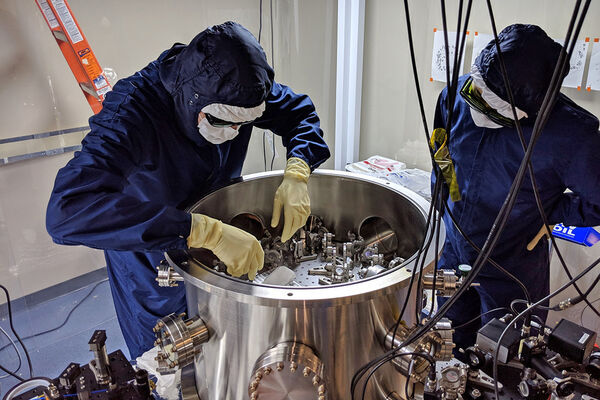
Designing new mirror materials for better gravitational-wave detection
"Nicholas Demos, a first-generation college graduate and MathWorks Fellow in MIT’s Kavli Institute, is improving our ability to listen to the cosmos. Nicholas Demos, a physics graduate student, didn’t travel a conventional path to MIT. A first-generation college student, Demos didn’t have a clear trajectory in mind when he first attended California State University at Fullerton after high school. “It was kind of the path of least resistance,” Demos says. When his father passed away in the middle of his undergraduate studies, Demos left school to run the family business, Novatech Lighting Systems, which makes handheld spotlights. He ran the company for five years, but business didn’t suit him, he says: “The pursuit of money wasn’t motivating at all to me.” As soon as his brother graduated and could take over the business, Demos was ready to go back to school — this time with a clearer purpose." [...]

Rice finds path to nanodiamond from graphene
"A spot of pressure enables chemical conversion to hardened 2D material Marrying two layers of graphene is an easy route to the blissful formation of nanoscale diamond, but sometimes thicker is better. While it may only take a bit of heat to turn a treated bilayer of the ultrathin material into a cubic lattice of diamane, a bit of pressure in just the right place can convert few-layer graphene as well. The otherwise chemically driven process is theoretically possible according to scientists at Rice University, who published their most recent thoughts on making high-quality diamane — the 2D form of diamond — in the journal Small. The research led by materials theorist Boris Yakobson and his colleagues at Rice’s Brown School of Engineering suggests a pinpoint of pressure on few-layer graphene, the atom-thin form of carbon known for its astonishing strength, can nucleate a surface chemical reaction with hydrogen or fluorine. From there, the diamondlike lattice should propagate throughout the material as atoms of hydrogen or fluorine alight on the top and bottom and covalently bind to the surfaces, prompting carbon-carbon connections between the layers. The pressure applied to that one spot — as small as a few nanometers – is entirely unnecessary for a bilayer but is needed and must be progressively stronger for thicker films, Yakobson said." [...]

60-year-old limit to lasers overturned by quantum researchers
"A team of Australian quantum theorists has shown how to break a bound that had been believed, for 60 years, to fundamentally limit the coherence of lasers. The coherence of a laser beam can be thought of as the number of photons (particles of light) emitted consecutively into the beam with the same phase (all waving together). It determines how well it can perform a wide variety of precision tasks, such as controlling all the components of a quantum computer. Now, in a paper published in Nature Physics, the researchers from Griffith University and Macquarie University have shown that new quantum technologies open the possibility of making this coherence vastly larger than was thought possible. “The conventional wisdom dates back to a famous 1958 paper by American physicists Arthur Schawlow and Charles Townes,” said Professor Howard Wiseman, project leader and Director of Griffith’s Centre for Quantum Dynamics. Each of them went on to win a Nobel prize for their laser work." [...]
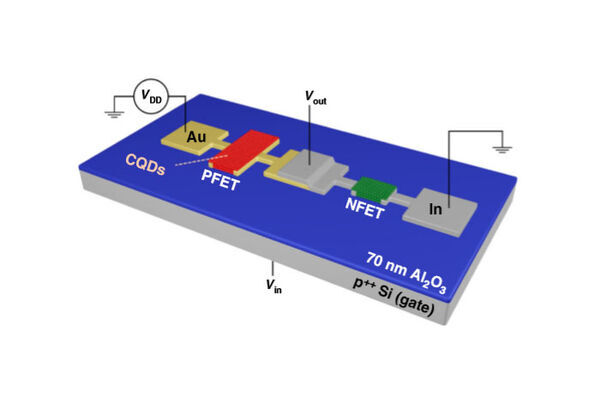
Breakthrough quantum-dot transistors create a flexible alternative to conventional electronics
"Quantum dot logic circuits provide the long-sought building blocks for innovative devices, including printable electronics, flexible displays, and medical diagnostics Researchers at Los Alamos National Laboratory and their collaborators from the University of California, Irvine have created fundamental electronic building blocks out of tiny structures known as quantum dots and used them to assemble functional logic circuits. The innovation promises a cheaper and manufacturing-friendly approach to complex electronic devices that can be fabricated in a chemistry laboratory via simple, solution-based techniques, and offer long-sought components for a host of innovative devices. “Potential applications of the new approach to electronic devices based on non-toxic quantum dots include printable circuits, flexible displays, lab-on-a-chip diagnostics, wearable devices, medical testing, smart implants, and biometrics,” said Victor Klimov, a physicist specializing in semiconductor nanocrystals at Los Alamos and lead author on a paper announcing the new results in the October 19 issue of Nature Communications. For decades, microelectronics has relied on extra-high purity silicon processed in a specially created clean-room environment. Recently, silicon-based microelectronics has been challenged by several alternative technologies that allow for fabricating complex electronic circuits outside a clean room, via inexpensive, readily accessible chemical techniques. Colloidal semiconductor nanoparticles made with chemistry methods in much less stringent environments are one such emerging technology." [...]
Documentação
A documentação é parte essencial do processo de aprendizagem e a Internet além de artigos interessantes de explorar também tem alguma documentação em formato PDF interessante de ler. Todos os links aqui apresentados são para conteúdo disponibilizado livremente pelo editor do livro.

The MagPI 99
"Discover an endless array of amazing gadgets, devices, and projects with our guide the greatest gear from the year. Inside The MagPi magazine #99 - Raspberry Pi Ultimate Wishlist. The ideal inventory for a Raspberry Pi owner with a mission to build something new. - Compute Module 4 specs and benchmarks. Putting the power of Raspberry Pi 4 in an embedded form factor. - Holiday Projects for a Festive season." [...]
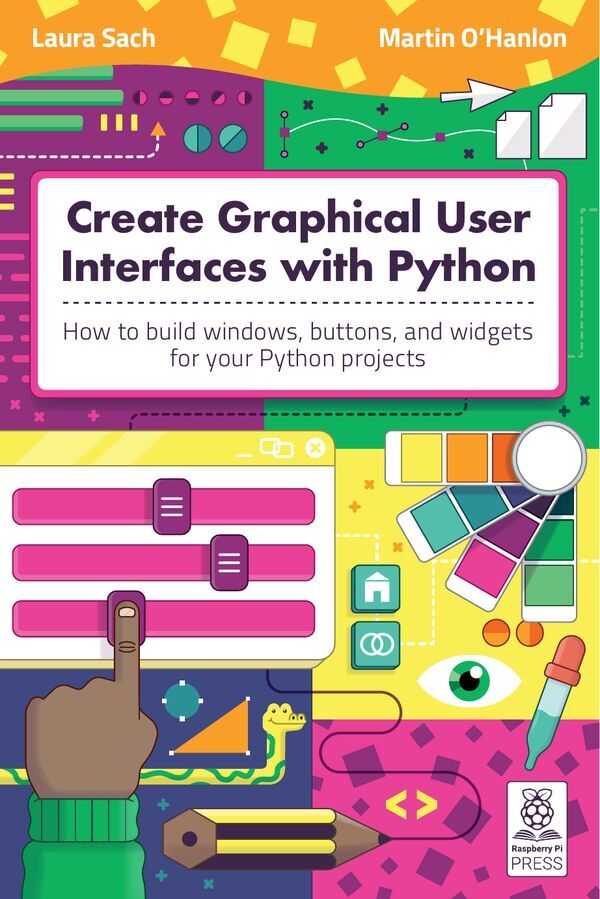
Create Graphical User Interfaces with Python
"Add buttons, boxes, pictures and colours and more to your Python programs using the guizero library, which is quick, accessible, and understandable for all. This 156-page book is suitable for everyone, from beginners to experienced Python programmers who want to explore graphical user interfaces (GUIs). There are ten fun projects for you to create, including a painting program, an emoji match game, and a stop-motion animation creator. Create games and fun Python programs Learn how to create your own graphical user interfaces Use windows, text boxes, buttons, images, and more Learn about event-based programming Explore good (and bad) user interface design" [...]

newelectronics 26 Outubro 2020
"New Electronics is a fortnightly magazine focusing on technological innovation, news and the latest developments in the electronics sector. Downloadable as a digital page turner or pdf file, or offered as a hard copy, the New Electronics magazine is available in a format to suit you. " [...]
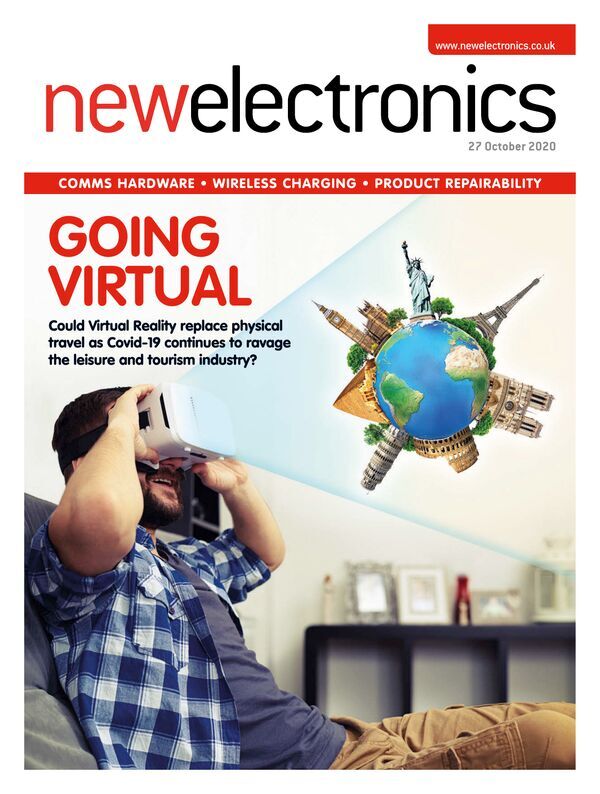
newelectronics 27 Outubro 2020
"New Electronics is a fortnightly magazine focusing on technological innovation, news and the latest developments in the electronics sector. Downloadable as a digital page turner or pdf file, or offered as a hard copy, the New Electronics magazine is available in a format to suit you. " [...]
Projetos Maker
Diversos Projetos interessantes.
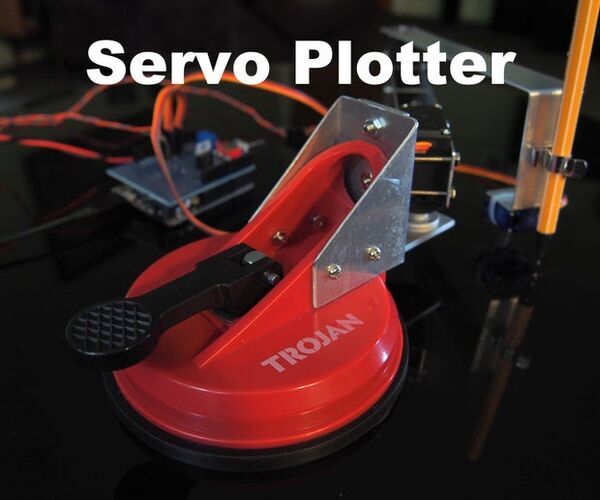
Servo Plotter
"This instructable explains how to make an A4 plotter using three servo motors and an Arduino UNO R3. Construction is simple ... all you require is a hacksaw, a sharp knife, and a 3mm drill. Two plotters are described: The first version, shown in photo 2, uses MG 996R metal gear servos. A second lightweight version using SG90 servos is shown in photo 5 Both plotters use the same software which features an onboard g-code interpreter that is Inkscape compatible. [1] The MG 996R plotter features a vacuum hold-down and a simple pen-lift. The reason that the sample plot in photo 6 looks weird is that servo1 is faulty ..." [...]

IoT Based Smart Irrigation System Using NodeMCU ESP8266 & Adafruit IO
"Farmers across the world face a lot of difficulties in growing crops because of unpredictable weather conditions and shortage of water. The traditional irrigation system uses a large amount of water and supplies uneven water to corps. This affects the quality of crops. Many farmers already start using the Greenhouse farming and Smart Irrigation System. Emerging IoT technologies and sensors are used to develop the irrigation system that can automatically supply water according to climate conditions like moisture value, temperature, etc. In this project, we are building an IoT based smart irrigation System using NodeMCU, Moisture sensor, and LDR." [...]

DIY Internet Controlled Smart Led Matrix (Adafruit + Esp8266 + Ws2812)
"Here is my 2nd advance to a project that I am very excited to show you. It's about a DIY Smart LED Matrix that will let you show on it, data, such as YouTube Stats, your Smart Home Stats, as temperature, humidity, can be a simple clock, or just show text and animations. In this second tutorial I will be sending text and color data through the internet. If you are a visual learner I know that a video worth more than 1000 words, so here is a Tutorial video. " [...]

ADDING a 3-Wire Laser to a CR-10S 3D Printer
"I wanted BOTH a 3D Printer AND a Laser - in one device. With minimal switcharoos necessary to go from one to the other. So, I modified my wonderful Creality CR10S 3D printer (an Instructables prize!) by adding an inexpensive "5.5W" 3-wire laser. Today, I'll show you how. Objectives: Mount a 3-wire laser on my CR-10S 3D printer Control it via the incredible LightBurn software Keep the CR10 still completely operable as a 3D printer without having to remove the laser." [...]
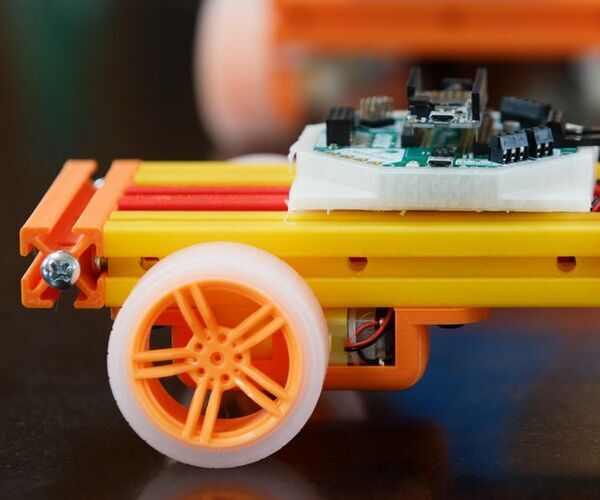
A Simple 3D Printed Robot
"Allow me to date myself. I grew up with erector sets and then LEGO. Later in life, I used 8020 to build prototypes types of systems I designed. There were usually scrap pieces around the house that my children used as their version of an erector set. The greatest thing about both of those building systems was that they were highly reusable. By breaking apart bricks or unscrewing some bolts, you could be off building somthing new in a couple of minutes." [...]
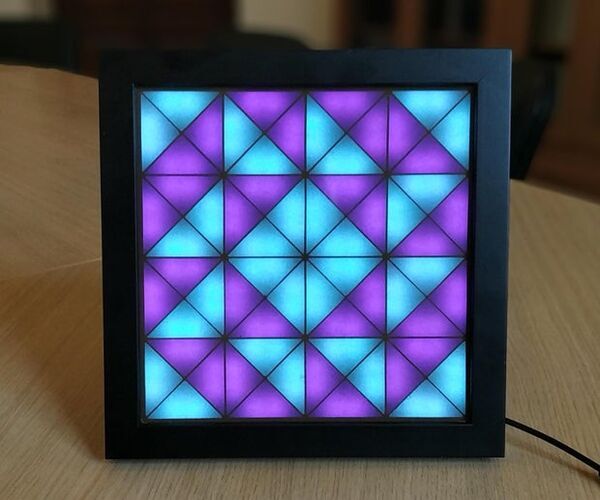
Half Square Triangles LED Art
"The idea for this project came to me during the construction of my previous project “Half Square Triangles Kinetic Art”. The project was quite difficult to complete, I succeeded, it's true, but I wanted to completely remake the project on other bases. That's how this concept of "HST LED Art" was born, meaning I used LEDs to display half square triangles models. Interestingly, during the design, I discovered that the LED arrangement I used can have other purposes: it can be a matrix display of 8x16 LEDs, it can be a display of 8x8 LEDs with 2 LEDs each in every cell... And there are a lot of projects based on matrix displays, my way of arranging LEDs can be applied to many of these projects, bringing a new approach... Some examples are here on instructables: Arduino RGB Matrix Word Clock Table Gadget With 8x8 LED RGB Matrix and Arduino Uno VERBIS - Desktop 8x8 RGB LED Matrix Word Clock ROME Clock For example, in my Verbis WordClock project, a blend is made between two colors to emphasize the words of the hour. The blend is made with a single LED, but with this project it could be done with two LEDs, one LED for one color, another LED for the other color and the ‘blend’ could be much more natural." [...]

DIY 3D LED Cube With a Raspberry Pi
"This project goes over how we made a DIY 3D LED Cube from ws2812b LEDs. The cube is 8x8x8 of LEDs, so 512 total, and the layers are made of acrylic sheets we got from home depot. The animations are powered by a raspberry pi and a 5V power source. The cube is a great piece to show off to friends and can act as a lamp. Ours is a little too big for a lamp (2ft x 2ft x 2ft), but you can scale this down to fit your needs. Supplies: ws2812b LED Bulbs - https://amzn.to/370NCK7 5V Power Supply - https://amzn.to/36VDylP Raspberry pi 3b I used (can use any) - https://amzn.to/36VDylP SN74HCT125 Integrated Circuit - jumps voltage from raspberry pi signal to have proper voltage for led strip (I usually get my circuit parts from Digikey) 4ft x 8ft acrylic sheet - Home Depot" [...]
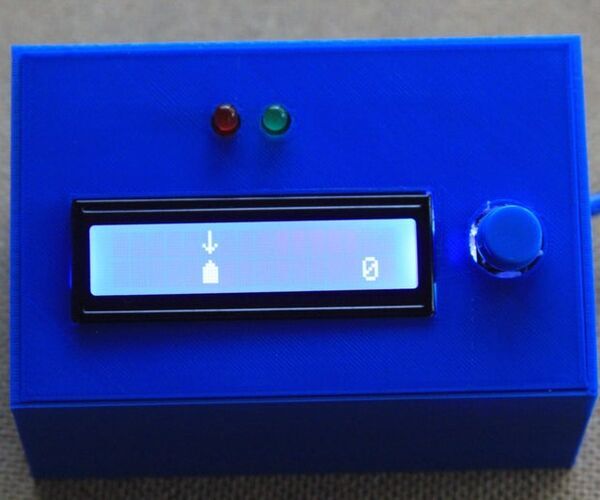
Press(Button); //An Arduino LCD Game
"Recently in Scouts, I worked on the Game Design merit badge. For one of the requirements, I built this game using Arduino that is based on the LED Rocker Game. The point of the game is to score the highest amount of points possible. At the start of the game, you will need to press the button to start, then there will be an arrow in the middle of the screen. There is another arrow below it that moves across the screen. When the arrows match, you need to press the button and hold it down until the green LED lights up." [...]
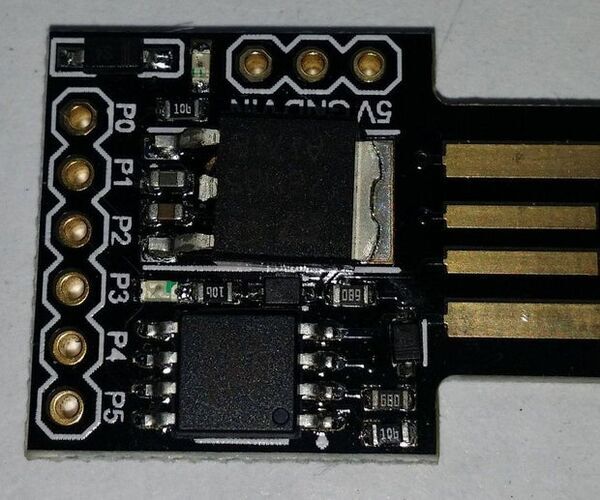
Reducing Battery Power Consumption for Digispark ATtiny85
"or: Running an Arduino with a 2032 coin cell for 2 years. Using your Digispark Arduino Board out of the box with an Arduino program it draws 20 mA at 5 volt. With a 5 volt power bank of 2000 mAh it will only run for 4 days. " [...]
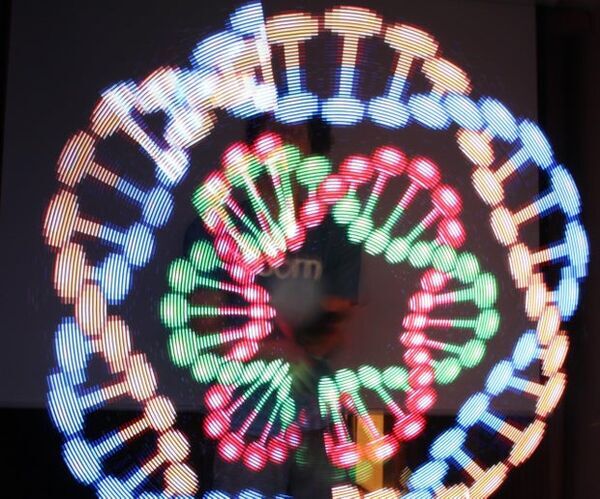
Persistence of Vision LED Staff
"It is well known that even after a light has been turned off, human eye keeps "seeing" it for a fraction of second. This is known as Persistence of Vision, or POV, and it allows one to "paint" pictures by quickly moving a strip of LEDs, drawing one line of an image at a time in quick succession. If you search online (e.g. on Etsy), you can find quite a few toys based on this idea: pois, staffs, and more. However, these are expensive: typical prices for a POV staff of decent resolution start at $500, and they use proprietary software, so there is no easy way to modify their behavior or add extra functionality. Thus, when looking for a birthday gift for a friend who enjoys painting with light, I decided to create my own open source version using readily available components." [...]
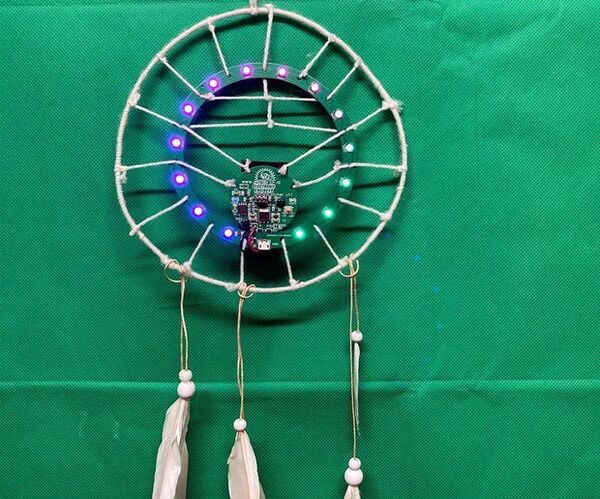
Dreamcatcher With Arduino Rainbow
"A few weeks ago, my daughter asked me about dreamcatchers and as most dad's do...I overwelmed her with fantastic stories about the power of dreamcatchers ....well..I might have overdone it a little because she was so impressed that she decided that she needs one! So, why not let her make one....well....that has something to do with the story I told her. True or not, but I kind of told her that a dreamcatcher is something that you will get as a gift. You can make one for a friend but if you make one for yourself, it will be a lot less powerfull. Duh, why did I say that? Now, I had to make her one!" [...]
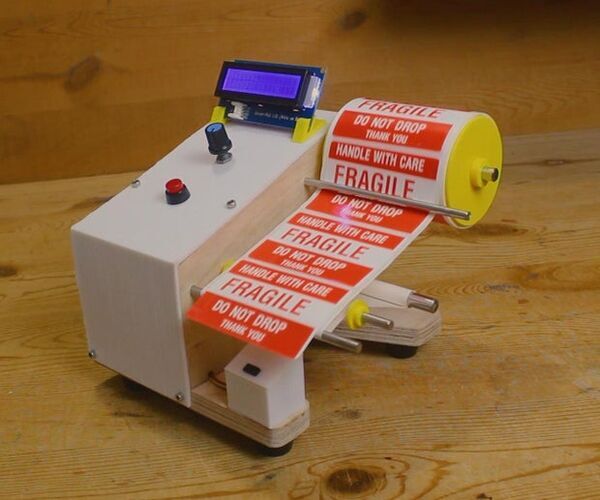
DIY Arduino Based Auto Label Dispenser Machine
"Hello makers in this video I have made a arduino based auto label dispenser machine, this machine dispense labels automatically. When you are in packaging and transporting industry there are continue parcel which need to label some sticker, this machine very much helpful there. It automatically peel off label and dispense this make process fast. For this I used arduino micro controller, stepper motor to feed label roll and IR sensor to detect label" [...]
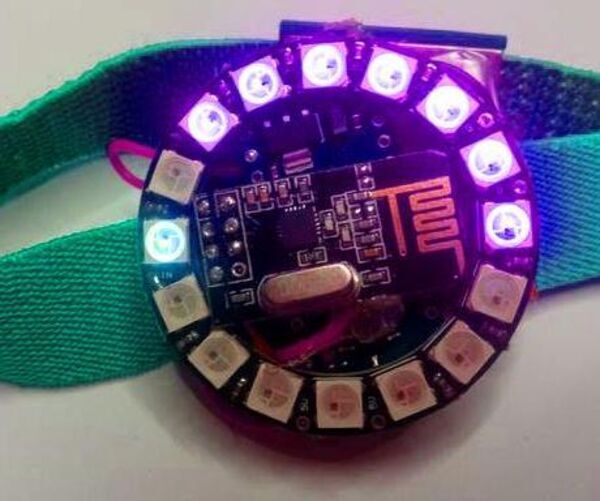
Wireless and Wearable Heart Rate Monitoring Device
"Health monitoring has always been a promising application for the Internet of Things (IoT). By using the right technology we no longer have to depend on our general routine health check-up or our local physicians to assess our body. Sensors can be used to measure all your body vitals and this information can be shared remotely in real-time for a doctor from other parts of the world to diagnosis you or perhaps an AI could crunch all the numbers and diagnosis your problem. Sounds futuristic, right? But we are gradually moving towards it and we are not very far from having remote IoT Robotic Arms performing surgery on us. Previously we built IoT Based Heartbeat Monitoring System using Raspberry Pi." [...]
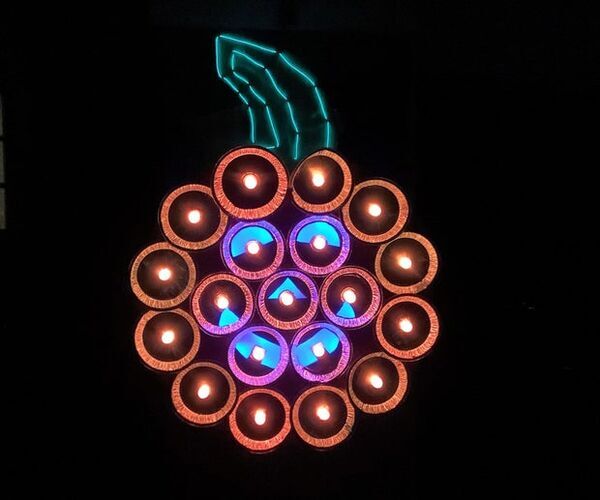
It's the Pie Tin Great Pumpkin
"Hey Charlie Brown fans, this project features a giant pumpkin's face carved into lighted pie tin reflectors. The pie tins are illuminated with two (2) strands of GE Color Effects color-changing LED holiday lights bulbs. The front string of iTwinkle GE lights is set to constant orange color, representing the 2D circular body of the pumpkin. Then, like a candle inside a real pumpkin, a second strand of GE lights is placed behind the pumpkin's body to provide an animated light show in the eyes, nose, and mouth which were carved into the seven central pie tins. Caution- this pumpkin has a wild side. Please see video for the Halloween night ghost bustin' light show, with the pumpkin changing colors in sync with MP3 music.." [...]
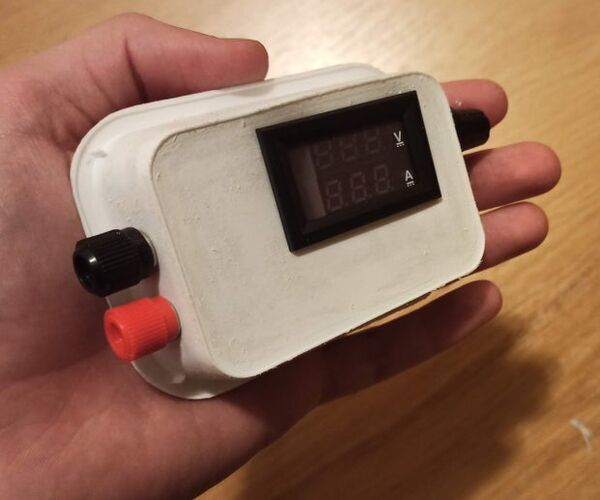
Small Portable Variable Power Supply
"Idea is to make small cheap portable variable power supply for hobbyists. It main purpose is to test some electronic components or to power some projects in their early development or for POC stage. Parts used in project are: - Digital voltmeter/ammeter - DSN-VC288 - DC-DC step-down buck-converter - LM2596 - 10k potenciometer - 2 output terminals - 2 input terminals - switch - some wires - some case from cream or something" [...]

Cryptic Auto-Calendar
"This is a remix of two great calendar Instructables. The first is the tomatoskins Automated Perpetual Calendar and the second is the cfb70 Cryptic Calendar. I have constructed a number of manual perpetual calendars in the past. The big drawback has always been remembering to advance the calendar each day. I was hooked as soon as I saw the tomatoskins version. I quickly built one; substituting some 3D-printed parts for the original wooden parts." [...]

DIY Smartphone LoRa Connection
"Here's how to connect your phone to a LoRa module using standard components you can buy everywhere, along with an example chat program. This project will help you create a connection between your phone and a LoRa module using the USB port and an Arduino Lilypad USB. There is an example chat app for point to point communication, and, you can modify it to make even a TTN sensor out of a smartphone :)" [...]
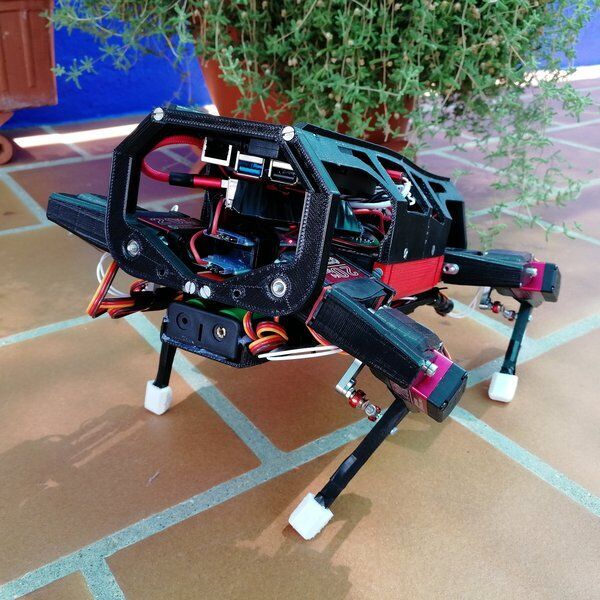
DIY hobby servos quadruped robot
"Cheap 3D printed 4 legged robot, that almost looks like boston dynamics spot but moves like a newborn. Being a undergradute in physics and bored of solving paper problems, i decided to solve and apply a real world problems so i started this robotics project in order to introduce my self to control theory, studying its maths and practicing pragramming. It runs with Raspberry Pi 4 as brain, plus an Arduino Mega for reading/writing of signals of 12 hobby servos and IMU, controlled by a PS3 Dualshock. The code which is mostly written by me, using python3 along with some typical libraries for the task, for now implements a walking loop inside a kinematic model, so you can command a pose to the body, as well as feet position and also velocity and directinal commands for the walking loop. Controlled by a ps3 controller via bluetooth. Arduino is used for speed up the reading and writing of signals, so in the future i can add other sensor, as well as position feedback..." [...]
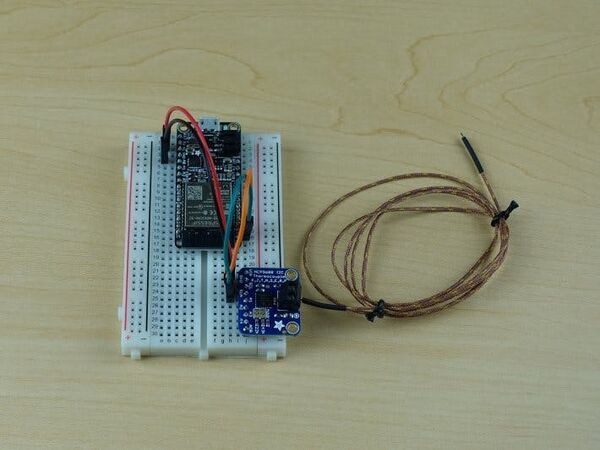
Azure Powered AI Freezer Monitor
"An anomaly detecting freezer monitor designed to work in ultra low temperature scientific freezers. The Azure Powered AI Freezer Monitor is a maker hardware based IoT monitor that uses machine learning, or ML, to provide early warnings of potential equipment failure. This guide covers building the device, collecting training data, setting up email alerts, training a custom auto encoder machine learning model, and deploying the model to an ESP32 development board. The project is designed to be functional for low temperature scientific freezers (-60 C), with the goal of reducing catastrophic failure and the need to keep backup freezers running full-time. However, please note that this project is primarily for demonstrative and educational purposes and has not gone through extensive testing. " [...]

Home Automation System
"This Home Automation System is design to control the speed of fan to cool the light bulb and perform several different functions. This system is designed to control the speed of the fan to cool a light bulb. We decided to build this project because today's light bulbs tend to heat and this can cause blast in the house. Which could turn out to be a huge fire accident! So, we have made an automation system which could be controlled by your smartphone. This will cool out the bulb and the speed also you can control by just sitting and do the work." [...]
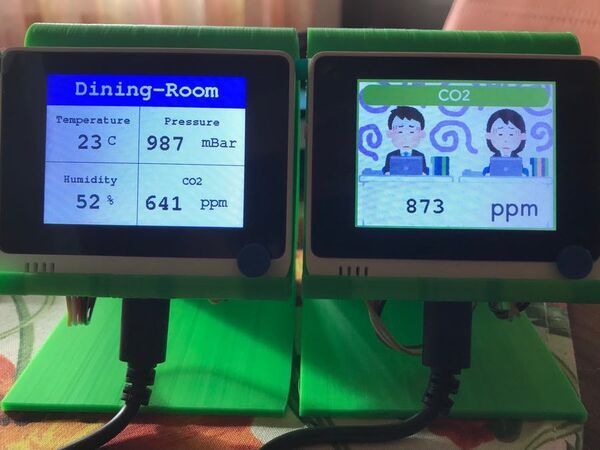
CO2 monitoring with WioTerminal
"WioTerminal with a CO2 sensor to measure the indoor air quality and remind to ventilate the room. Useful IoT device - 2020 Corona Pandemie. According to the current state of science (Fennelly, Lancet, 2020), tiny drops of liquid (aerosols) play a much larger role in the spread of respiratory infections than previously thought. Too little ventilation increases the risk of illness, too much ventilation is harmful to the environment. With this hands-on project for demand-oriented ventilation, we would like to take the initiative to make regular operations a little safer in Corona times and at the same time to appreciate climate protection. Even after the pandemic, targeted ventilation helps us to stop creeping fatigue processes in class." [...]

USB-C PD Sink BCR
"A USB-C Power Delivery Sink, handling up to 20V 5A based on the Cypress CYPD3177 USB PD Controller. USB-C Power Delivery offers the option to negotiate power delivery from a compatible PD power supply. The USB-C PD-Sink plays the role of a sink device, enabling any device to be powered from a USB-PB power supply. Any type of power connector can be attached through a 2-pin screw terminal or directly soldered into the PCB for a lower profile. The voltage can be set to 5V, 9V, 12V, or 20V and current can be set to 1A, 2A, 3A, or 5A. BCR stands for Barrel Connector Replacement, the term is invented by Cypress, the manufacturer of the controller chip in use here." [...]

MagicMirror Alarm Clock
"A compact alarm clock for your bedside table, with time, date, weather, news... and a relaxing sound to wake you up. Yes, this is yet another alarm clock! But I feel like I'm not the only one deisiring a nice and simple object like this one to keep on the bedside table. It comes with useful features like a soft wake up (with chirping birds from a little bluetooth speaker), changing set of information and luminosity for day and night, weather, news. WiFi is turned off during sleep time. All very customizable!" [...]
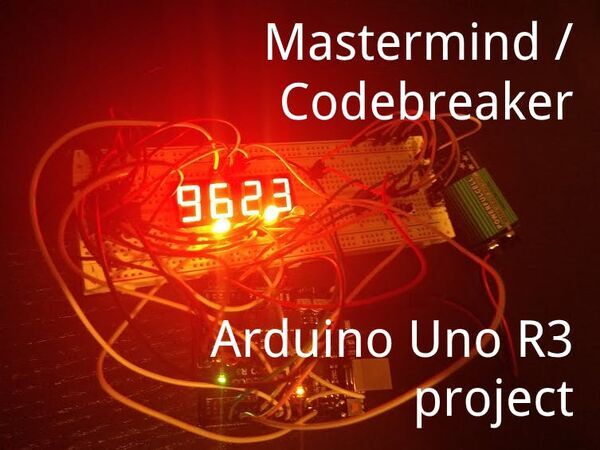
Mastermind/Codebreaker game on Uno R3
"An Uno R3 version of the famous mastermind/Codebreaker game. Can you crack the code in 10 guesses? Uses basic components found in most kits. As I just got my first board, I wanted a simple goal to accomplish, mainly to get used to wiring up a board and writing c++. I envisioned a simple Mastermind/Codebreaker game. The rules are simple: the goal is to guess the code, you have 10 guesses to find it out." [...]
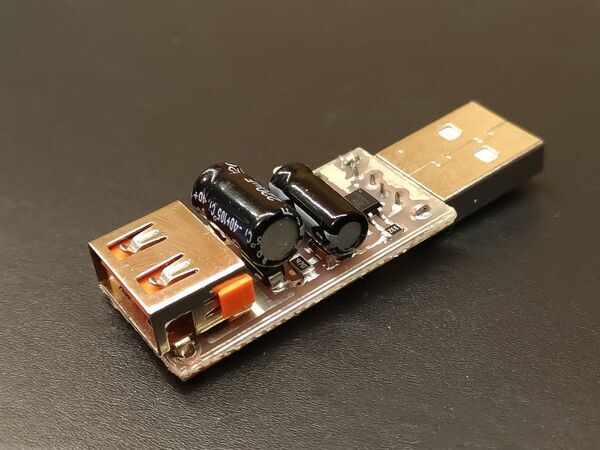
Power Bank "Keep-Alive"
"A simple module to keep power banks from turning off, when your DIY circuit draws low currents. A simple power bank - keep alive module. As the name is already suggesting, this module keeps power banks from auto turn off, when the load current is too low. The power banks usually monitor the current drawn from the usb, in order to find out if the connected mobile phone is charged, and if it is, turn off the output. This feature is good for usual purposes, or DIY circuits which draw a current above 100 milliamps; but not for tiny circuits with a supply current lower than 100mA. This simple 555 based circuit, is an astable multivibrator with a period of ~5 seconds and a duty cycle of just 2%." [...]

Time Lapse Raspberry Pi Zero W
"Create a Time-Lapse device using the small and cheap Raspberry Pi Zero W and a camera. Enjoy it. I bought a Raspberry Pi Zero W kits some months ago and I have not had time to work with it. I decided to make an easy project with a camera. This project will help you to start learning to use a Raspberry Pi and you will see that board as a great tool for your future projects. We need a Raspberry Pi Zero W kit." [...]
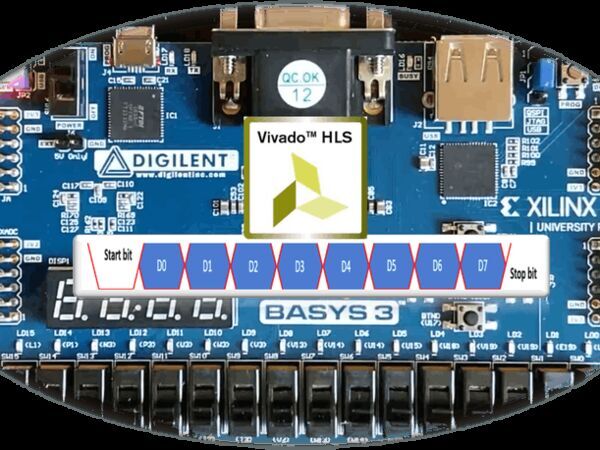
UART Transmit with HLS for FPGA
"This project implements a UART transmit logic design in HLS. Like my previous projects, this one also demonstrates that “Designing digital systems with HLS for FPGA is fun”. If you are interested in learning HLS coding techniques please refer here or here. UART is an old mechanism for serial communication which still is used in several electronic boards and computing platforms. Its implementation in an HDL language is not tricky and can be considered as an undergraduate homework. Here, I am going to take this example and show how easy and fun it is to implement that in HLS." [...]
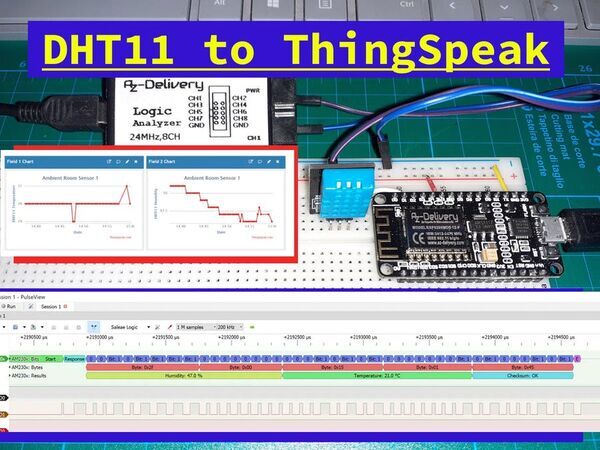
DHT11 Arduino Library and ThingSpeak
"DHT11 Temp and Humidity library from scratch to send data to ThinkSpeak with an AZDelivery ESP8266 ESP-12F NodeMCU Lua Amica V2 In this project I develop an Arduino library to read the data generated by the DHT11 Humidity and Temperature sensor to send it continuously to the ThingSpeak cloud services with an AZDelivery ESP8266 ESP-12F NodeMCU Lua Amica V2. There are many libraries ready to use to read DHT11 sensor data. So, why reinvent the rule? Just for the pleasure of understanding how things work and maybe improving them. I use a logic analyzer and the DHT11 sensor datasheets to understand the protocol and develop my own library for the sensor.DHT11 Temperature & Humidity Sensor DHT11 Temperature & Humidity Sensor features a temperature & humidity sensor complex with a calibrated digital signal output. By using the exclusive digital-signal-acquisition technique and temperature & humidity sensing technology, it ensures high reliability and excellent long-term stability." [...]
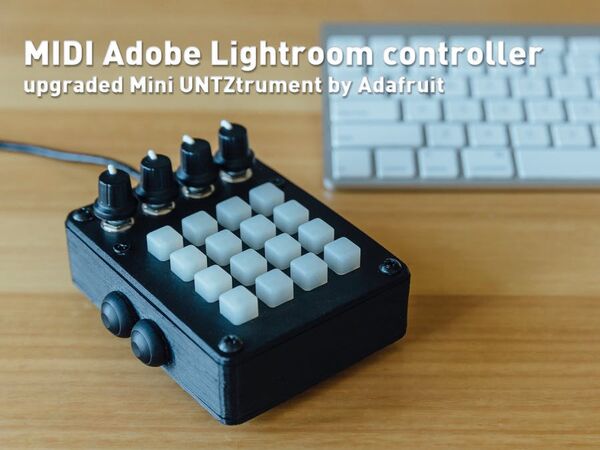
MIDI Adobe Lightroom controller
"An upgraded version of the Mini UNTZtrument by Adafruit Being a commercial photographer I use Lightroom almost daily. I am always trying to save time sitting in front of the computer, especially when working on a lot of different images at the same time. Using a dedicated controller for Lightroom can be extremely time saving and I was looking for an affordobale DIY version - small enough to fit into one hand while using by other hand to control it. Adafruit has some great and detailed projects on their website and I stumbled upon this one: https://learn.adafruit.com/mini-untztrument-3d-printed-midi-controller/overview This looked very promising and I just needed to change a few details to make it more suitable as a Lightroom MIDI controller. Replace the 4 analogue potentiometers with digital Encoders to avoid start and end points Add pushbuttons to add more functionality Make the main body slimmer Reinforce the USB connector So, I slightly revised the main body but mainly followed their detailed instructions to put it all together. I additionally drilled 4 holes (2 on each side) for the 4 pushbuttons." [...]

ESP32 WiFi Remote
"Make a WiFi controlled remote using ESP32 and couple of additional components. Complete how-to guide and a detailed walktrough is available at YouTube. " [...]
That's all Folks!



